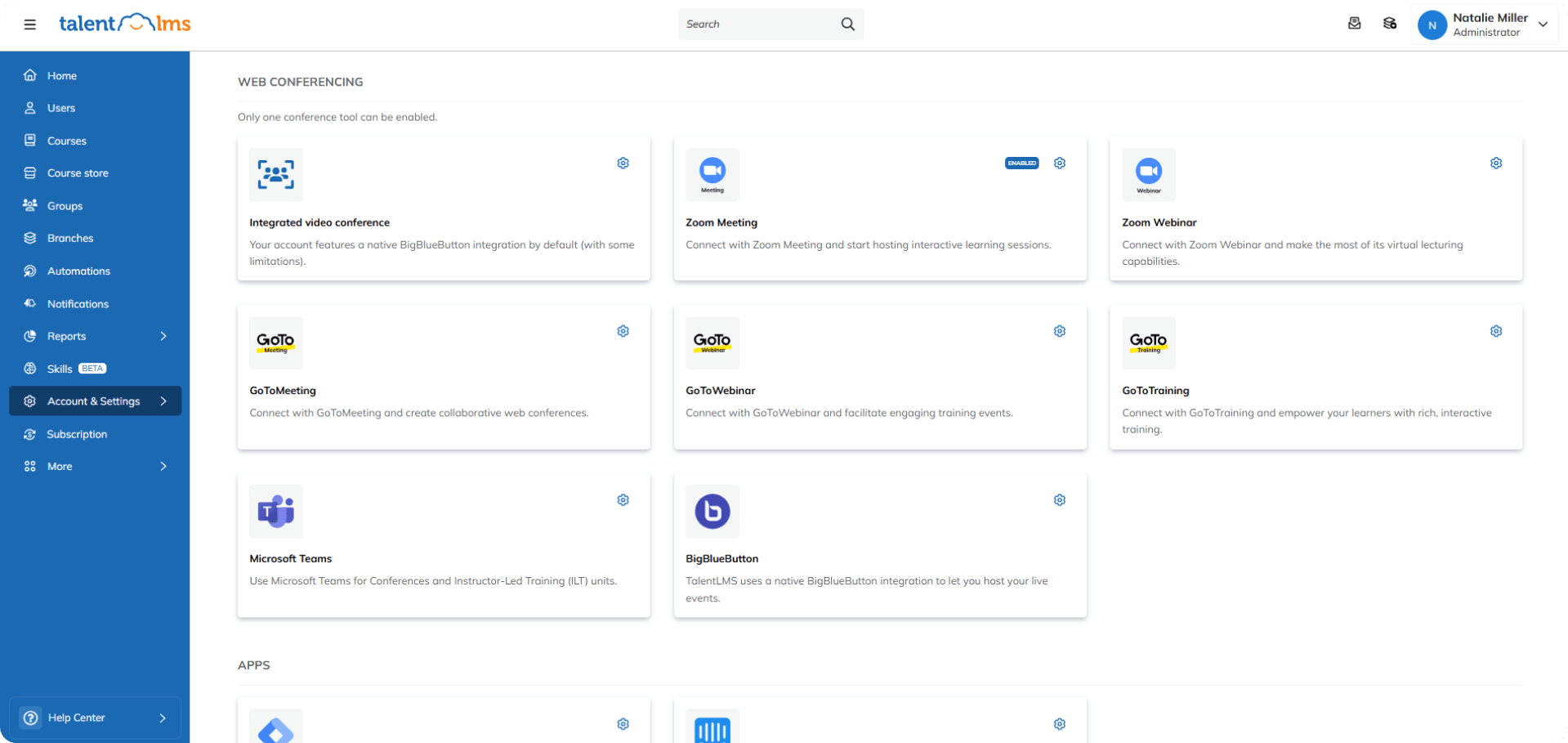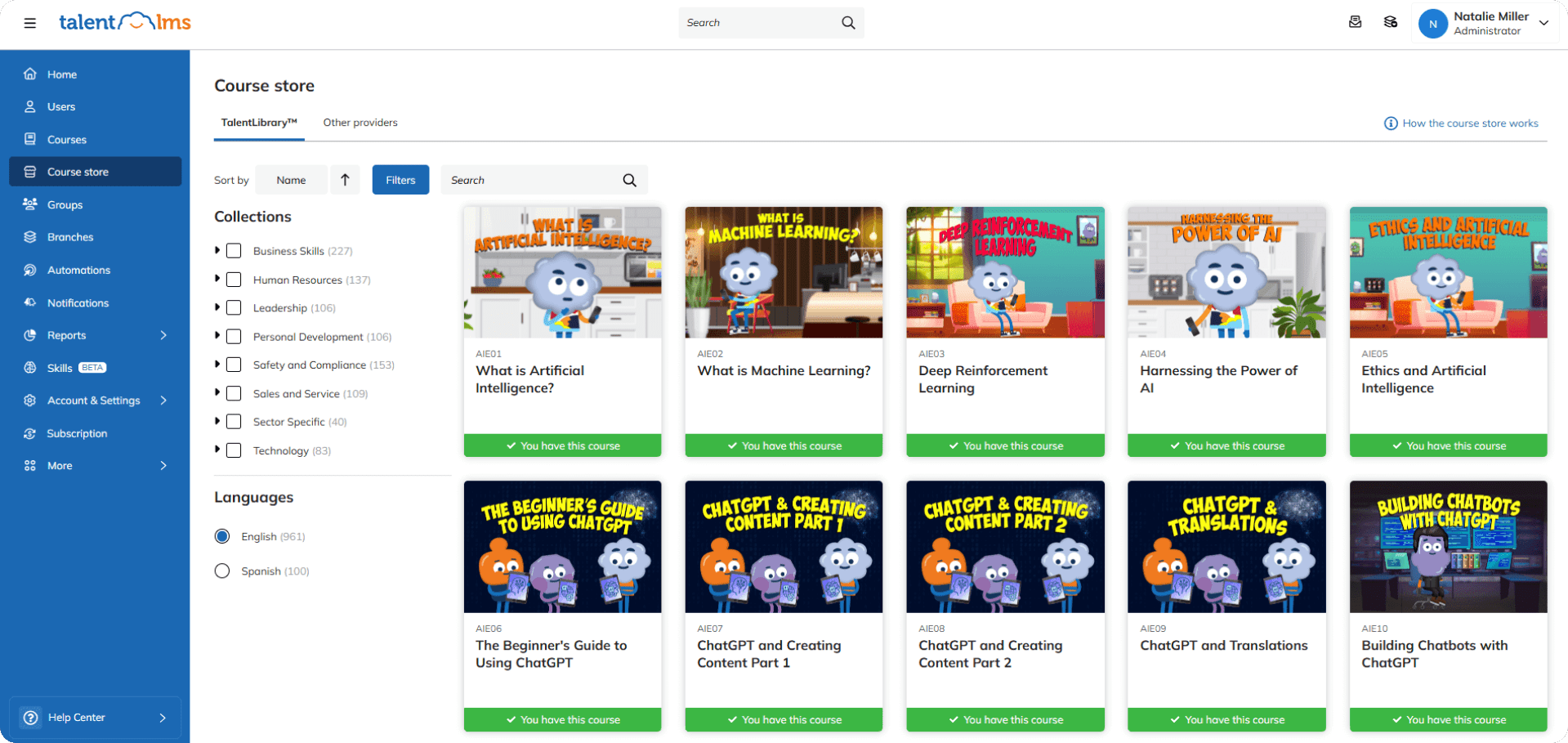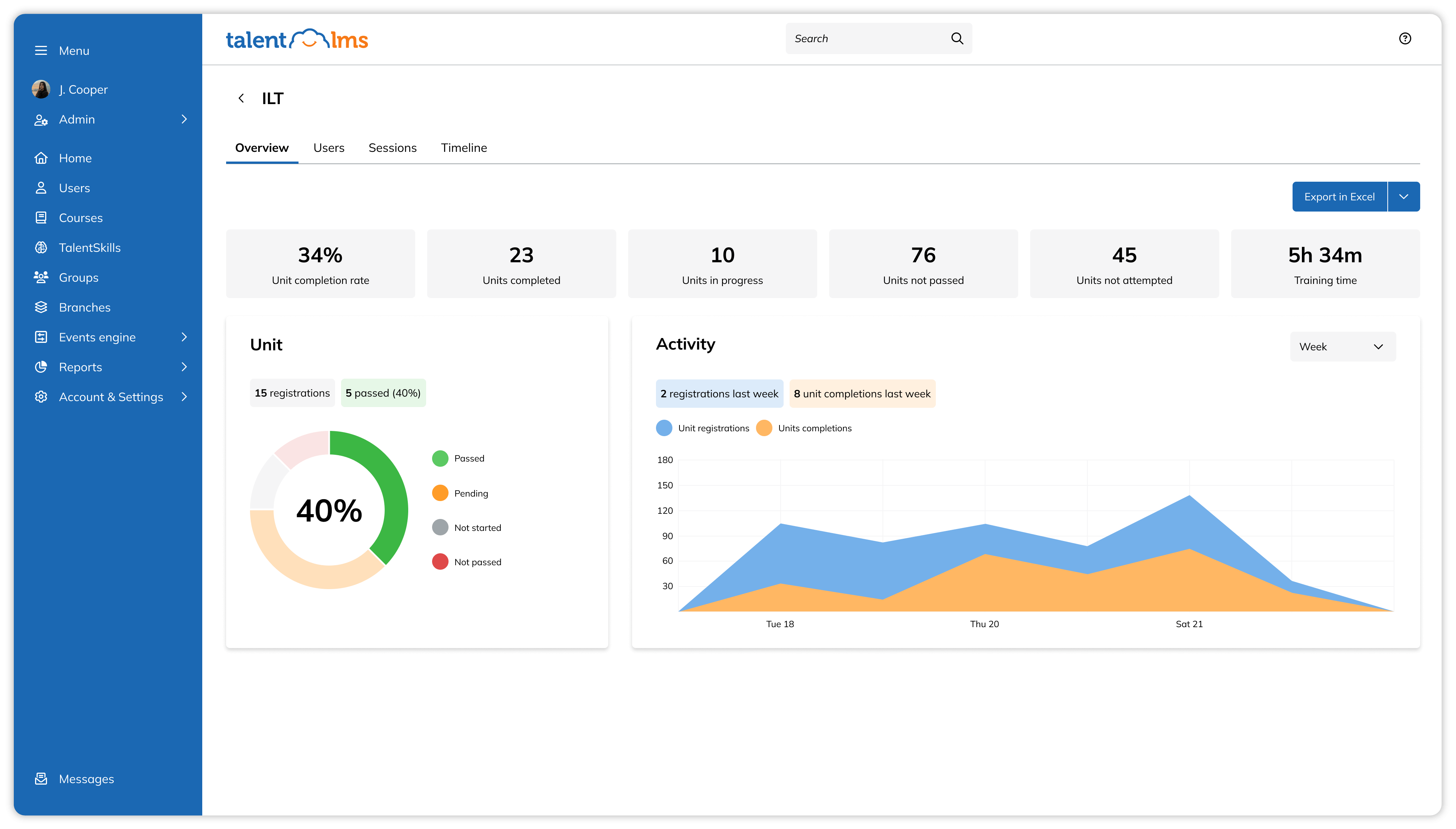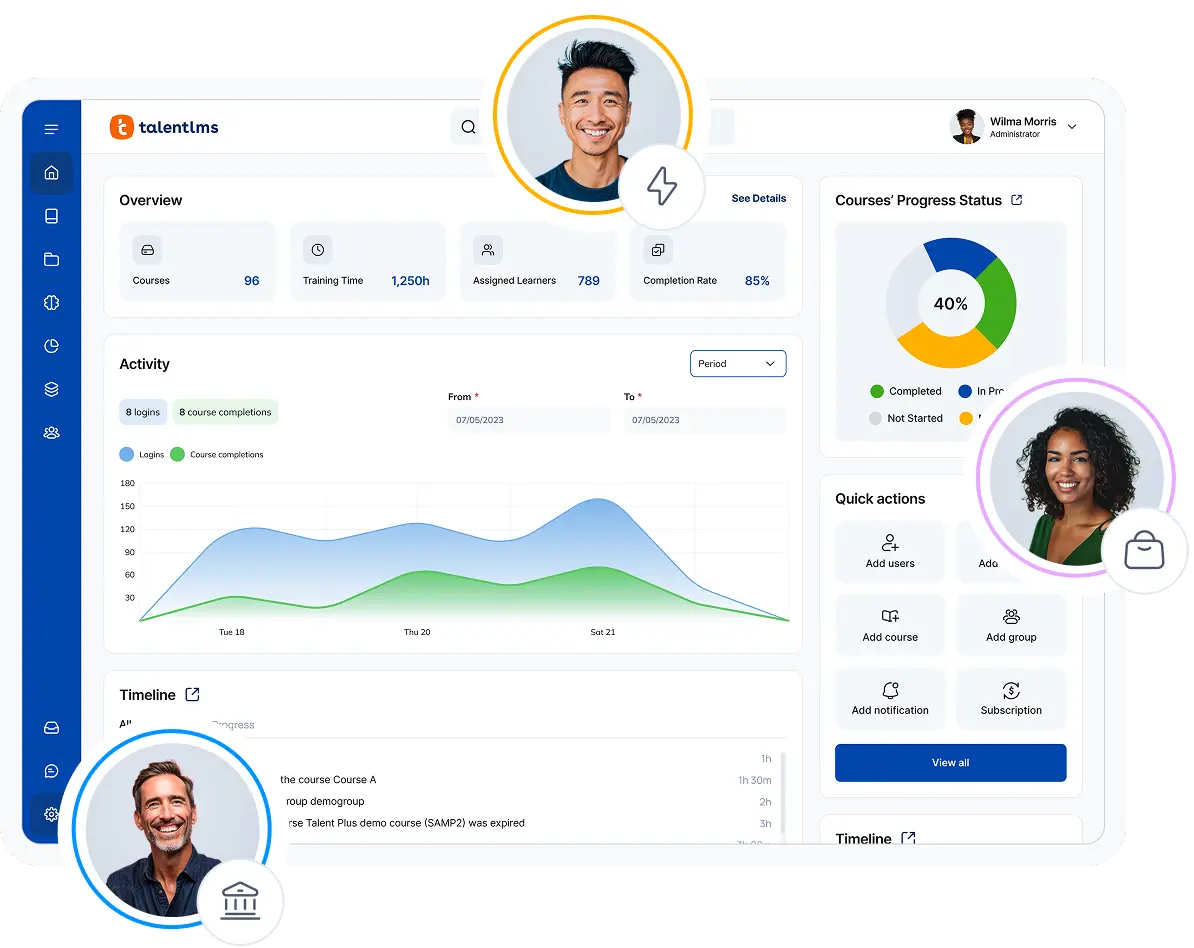Imagine a team brimming with untapped potential, each member eager to grow but unsure where to begin. How do you transform potential into performance? Effective employee training holds the key.
Let’s explore what is employee training, why it matters, and how to make it work for your teams.
What is employee training?
Successful employee training and development transform both individual employees and entire businesses—helping teams improve today, perform better, and grow in the long term.
But, employee training and employee development play slightly different roles. Training programs teach employees skills for the position they’re currently in. While development programs give employees the tools to progress in their careers. In fact, 71% of employees report feeling more prepared for the future of work because of the training they received.
Together, effective employee training and development lead to smarter, more capable, and more successful teams.
Why employee training matters
So, what’s the importance of training employees? Employee training and development aren’t just a nice-to-have. They’re a major factor in driving business success. Organizations that invest in nurturing talent enjoy more stability, higher engagement, and significant growth down the line.
The case for corporate training is an easy one to make. Robust training programs have been proven to lower turnover, increase profits, and keep businesses competitive. But beyond these tangible outcomes, they also cultivate a culture of continuous improvement, fostering innovation and resilience in the face of industry changes.
Effective employee training doesn’t just benefit employees; it benefits the organization as a whole. It equips teams with the skills to adapt to emerging technologies, meet customer expectations, and tackle challenges proactively. Moreover, it enhances employee satisfaction by showing a commitment to their professional growth, creating a motivated and loyal workforce.
Today, training is no longer optional—it’s a strategic imperative for staying ahead. Organizations that prioritize training are not just preparing for the future; they’re building it.
How company training benefits employees
Here’s how employees can benefit from company training:
Skills become more relevant
Company training empowers employees to succeed in their roles. It helps them gain new skills and stay up-to-date with industry standards. This keeps their knowledge relevant in the fast-changing business world. As employees grow, they become more confident and capable. Which, ultimately, leads to steady development, improvement, and better job performance.
Higher morale and motivation
Employee training programs foster a sense of belonging and motivation. When organizations invest in their employees, it shows they are valued and supported. This boosts morale and builds a positive workplace culture. Regular training also reduces workplace stress by giving employees the tools they need to meet challenges head-on. A motivated team is more collaborative, resilient, and driven to achieve company goals.
More opportunities for career growth
Training creates opportunities for career advancement. It reinforces employees’ commitment to the organization. Effective training also increases job satisfaction, making employees more engaged, productive, and fulfilled.
How employee training benefits employers
Here’s how organizations can benefit from employee training and development:
Top talent attraction and retention
Training helps attract skilled candidates and keeps employees engaged. It reduces turnover and lowers recruitment costs. Development opportunities also improve your company’s reputation as an employer.
Reduced risks and ensured compliance
Regular employee training increases employees’ likelihood of following safety and legal standards, lowers risks, and prevents costly penalties. Frequent updates also prepare teams for new regulations and industry changes.
Improved performance and profitability
Training programs boost efficiency and reduce employee errors. Better performance leads to higher profits. Organizations also save money by minimizing downtime and improving productivity.
More innovation and teamwork
Employee training sparks fresh ideas and new solutions. It helps teams collaborate better and adapt to change. Leadership training also builds stronger managers who guide teams effectively.
Enhanced employee well-being
Employee training programs can achieve employee well-being and reduce stress levels. Training sessions on safety and time management create healthier workplaces. Happier employees perform better and are less likely to burn out.
Popular types of employee training programs
Let’s explore the most popular types of employee training programs in organizations.
Onboarding and orientation training
Bring your new employees smoothly aboard. Onboarding and orientation training introduces new recruits to their role and your organization. Done right, it’ll point them in the direction of success and boost job satisfaction.
Start by furnishing your new employees with a detailed job description, so they know exactly what’s expected of them (and can refer back at any point if they’re unsure), company rules, and departmental guidelines. Add to that any role-specific or compliance training, and you’ve got a great base to start building a fully-contributing team member.
Expert tips:
- Personalize onboarding programs for each department to make new hires feel valued.
- Incorporate mentorship opportunities to facilitate seamless integration into teams.
- Use engaging training formats, such as interactive videos or gamified modules, to make the content stick.
Sales training
Intended to create salespeople who can apply sales concepts rather than parrot product brochures. Of course, product training is a natural and essential part of the role. But, you’ll want to include courses on how to connect prospects’ needs with your services or offerings, so your people can position your product as the perfect solution.
That way, you’ll be able to grow winning behaviors in your team. Behaviors that’ll see them clinch more deals (fingers crossed), meet and beat their quotas, and secure your org a rise in profitability.
Expert tips:
- Use role-playing exercises to simulate real-world sales scenarios and build confidence.
- Regularly refresh training to align with emerging market trends and customer needs.
- Provide advanced skill development opportunities for seasoned salespeople.
Customer service training
Nobody wants to feel like they’re speaking to a robot when all they want is a solution. Which is why you should train your support reps, and not just hand them lines to read. Because, sooner or later, a customer is bound to go off script and your people won’t be able to improvise.
The ultimate goal of customer service training is to improve customer satisfaction. To do that, your team will need effective employee training on listening and communication skills. Build these and see your reps positively engage with some of your most valuable stakeholders to offer solutions, boost your NPS, and secure business growth.
Expert tips:
- Leverage scenario-based exercises to prepare reps for unpredictable customer interactions.
- Teach empathy through tools like customer personas or case studies to deepen understanding.
- Offer real-time feedback during practice sessions to refine skills.
Leadership and management training
Out with the micromanagement, in with the inspirational leaders. No employee wants an overbearing boss, and neither should any business. Instead, train your leaders’ emotional and cultural intelligence to help them become better caretakers of their teams and encourage improved performance.
With great responsibility, comes great accountability. Which is why your managers will need training on how to make decisions correctly the first time around to boost trust and productivity.
Expert tips:
- Use 360-degree feedback tools to identify development areas and track progress.
- Teach strategic decision-making with case studies and role-based simulations.
- Provide opportunities for leaders to practice skills in real settings through job shadowing.
Technical and skills training
Pretty much every job needs technical skills. Technical skills are the hard skills employees use to complete tasks on a day-to-day basis. They range from the basic, such as cloud computing, to the more advanced, such as heavy machinery operation or complex data analysis.
Regardless of the level of difficulty, hard skills are specialized and essential. So, you’ll need to run an initial assessment, identify what skills your people lack, and then assign targeted online training and development to transform deficiencies into proficiencies.
Expert tips:
- Partner with industry experts to design and deliver specialized training modules.
- Offer microlearning for easier understanding and retention of technical concepts.
- Regularly reassess skill gaps to ensure training evolves with organizational needs.
Diversity and inclusion training
D&I, DEI, E&D. There are plenty of acronyms for diversity, equity/equality, and inclusion. Whichever one you use, the aim of diversity and inclusion training stays the same. Which is to make work a more supportive and inclusive environment.
Train your employees to be patient, understanding, and play an active role in being allies to less represented groups in your workforce. You may view DEI as a nice to have, but including it in your training program will encourage smoother collaboration, increased retention, and better performance.
Expert tips:
- Use real-world stories and case studies to make D&I concepts relatable and impactful.
- Make D&I an ongoing initiative through regular follow-ups and reinforcement activities.
- Foster open discussions to allow employees to share perspectives and learn from one another.
Compliance and ethics training
In highly regulated industries, compliance training comes as a standard. It’s the type of employee training designed to minimize risk from accidents and legal repercussions. Educate your people on mandated policies, legislation, and regulations they need to follow and put into practice to avoid potential misconduct.
Ethics training, on the other hand, aims to outline the set of principles your employees should make decisions based upon. Essentially, you’ll want to align your employees’ business decisions with your company culture.
Expert tips:
- Gamify compliance training to keep it engaging and memorable.
- Use real-life scenarios to help employees connect policies with day-to-day actions.
- Provide accessible resources for employees to consult after the training.
Cybersecurity training
In the digital age, your sensitive data is increasingly under threat. And while investing in cybersecurity software is great, your biggest liability will be human error. So, to secure your org against risk, it’s a wise idea to include cybersecurity training in your employee L&D program. Get your people up to speed on how to identify and respond to threats. With best practices and processes to mitigate against online risk in place, you can rest easy.
Expert tips:
- Simulate phishing attacks to test employee awareness and reinforce training.
- Tailor cybersecurity content to job-specific risks and responsibilities.
- Update training frequently to address the latest threats and vulnerabilities.
Team building and communication training
There’s nothing that halts progress quite like a team that doesn’t work well together. Get your people on track to success with team-building courses. Promote emotional understanding, break down barriers to communication, and cover more ground. Create a cooperative culture and start working towards a common goal, together.
Expert tips:
- Use personality assessments (e.g., MBTI or DISC) to foster better interpersonal understanding.
- Incorporate fun, collaborative challenges to encourage teamwork in low-pressure environments.
- Provide actionable takeaways for employees to apply and sustain improvements long-term.
Employee training methods
So, now you’re familiar with some of the more popular types of employee training, what about the ways to get it done?
Let’s take a look at the most popular training methods.
eLearning
eLearning delivers employee training through digital platforms, with the help of videos, interactive modules, quizzes, and more. This allows employees to learn at their own pace, and anytime, anywhere. It’s ideal for remote employees or large organizations as it ensures consistent and engaging training and development while tracking progress through built-in analytics.
Blended learning
Combine online training with in-person sessions using blended learning. This is an amazing way to offer flexibility and a comprehensive learning experience to your employees. Blended learning is valuable when topics require both theoretical understanding and hands-on practice, catering to diverse learning preferences.
On-the-job training
On-the-job training is a type of training program done under supervision. Tasks, processes, or procedures are explained and then demonstrated by a skilled employee, and then repeated by the learner.
Job shadowing
Job shadowing is similar to on-the-job training. Generally, it lacks practical application and relies on the learner to follow and observe another employee in their day-to-day routine.
Job shadowing is commonplace when onboarding new employees, or in the case of students and interns.
Simulation
Simulation training is especially useful when you have high-risk procedures to demonstrate.
You can recreate real-life situations and introduce your learners to them. In doing so, you’ll help your people get to grips with their role and develop employee skills without any of the risks of going in blind.
Coaching and mentoring
Coaching and mentoring are another type of one-to-one employee training. They pair an employee with a more experienced individual, with the intent of downward knowledge transfer.
While there are many similarities, the most important distinction between the two is that coaching focuses on the here and now, and aims to furnish the employee with skills to succeed in their current role. Mentoring focuses on progressing an employee in their career.
Employee training best practices
Training employees effectively doesn’t just happen.
It’s built on smart strategies that drive results and keep learners engaged. Here are the employee best practices you should keep in mind:
Align training with business goals
Tie training directly to strategic objectives to boost its impact on organizational success. Training that’s aligned with business priorities ensures employees add meaningful value to organizational growth.
Identify needs
Pinpoint knowledge or skills gaps through data-driven assessments and employee feedback. This helps focus your training efforts on what matters most, plus it saves time and resources.
Set clear objectives
What does success look like for every training program? Clearly outline your goals and give employees a target to aim for. This helps create accountability and make progress measurable.
Customize learning content and make it engaging
Develop role-specific material that resonates with employees’ daily tasks. Personalization boosts engagement and ensures content feels relevant and actionable. Also, try to make training an enjoyable experience by using interactive content, relatable examples, and engaging techniques like gamification. Engaged employees are more likely to retain knowledge and apply it effectively.
Leverage technology
Use handy tools to simplify access, track progress, and deliver dynamic content. Advanced tools enhance training delivery and provide actionable insights.
Encourage peer learning
Learning from peers builds stronger bonds and reinforces knowledge sharing. Foster collaboration by allowing employees to share insights and learn from one another, on the job, during Q&A sessions, or on discussion boards.
Track progress and gather feedback
It’s crucial to measure outcomes regularly to make sure your training delivers the results you want. Track progress data to refine training programs and monitor ROI. Plus, don’t omit listening to learner feedback to continuously improve and adjust training based on their needs.
Employee training tools and software
To enjoy the above advantages and avoid almost all the disadvantages, organizations are progressively making the switch from traditional methods to online software. And the use of the right employee training software and tools can have a huge impact on the successful training of your people.
But when typing “best employee training tools” into Google garners you pages upon pages of results, where do you actually begin?
Manually sifting through the links sounds like a chore. Worry not. These are the most necessary tools and software you need for training employees:
Learning Management Systems (LMS): Centralized platforms to host, deliver, and track training programs efficiently.
eLearning authoring tools: Create engaging, interactive courses, multimedia content, and presentations tailored to learners’ needs.
Assessment and testing software: Design quizzes, tests, and certifications to measure knowledge and skill levels.
Video training tools: Platforms for producing and sharing video-based content like tutorials, webinars, and demonstrations.
Gamification tools: Add game-like elements such as badges, leaderboards, and rewards to make learning more engaging.
Video conferencing software: Facilitate live, interactive training sessions via video conferencing with real-time collaboration. One of the best Learning Management Systems, TalentLMS, offers video conferencing integrations to keep all your tools in one place.

Mobile learning applications: Allow for on-the-go training with apps optimized for mobile devices.
Employee performance management software: Track and analyze your learners’ progress to align training with individual and organizational goals.
Content libraries: Access a wide range of pre-built courses and resources that cover various topics and skills for your online training.

Collaboration and communication tools: Encourage team discussions, peer learning, and real-time interaction during training sessions or asynchronously.
Analytics and reporting tools: Get insights on training effectiveness, participation rates, and learner outcomes to refine strategies. TalentLMS offers integrated analytics and reporting tools to keep everything in one platform.

AI-powered training tools: Use AI to create tailored training content and enhance learner engagement. With TalentCraft, content creation is now made easy and stress free.
Social media: Social platforms help share learning resources, foster peer-to-peer collaboration, and engage employees in discussions through social learning.
Video editing tools: Create professional-quality training videos with tools that support editing, effects, and subtitles, to enhance the visual learning experience and accessibility.
Employee training trends for 2025
The landscape of online learning is continuously changing. Now, in 2025, it’s set to redefine how organizations approach learning.
Here’s a closer look:
AI revolution
AI tools keep transforming training. They allow for more personalization, skill gaps identification, and tailored content generation. From virtual tutors to predictive analytics, AI continues to make training smarter, faster, and more efficient. However, while the L&D community embraces these innovations, ethical considerations and data transparency remain critical.
Rapid upskilling
Technology continues to evolve at breakneck speed. And so do the demands on the workforce. 77% of employees agree that learning new skills gives them a sense of purpose.
Fast employee upskilling and reskilling focuses on providing on-time, practical training that equips employees with the tools they need to stay ahead of the curve. This employee training trend for 2025 emphasizes speed without compromising quality, helping organizations stay agile.
Skills over roles
The focus is shifting from job titles to specific, measurable competencies. Skills-based learning empowers employees with the precise abilities they need for evolving roles. Which, in turn, ensures companies can adapt to future challenges. Everything is about future-proofing your workforce. Not just about filling current gaps.
Map and manage your employees’ skills with Skills’ AI-driven capabilities that help you save time, cut costs, and unlock team potential.
Soft skills continue to shine
AI and automations keep handling technical tasks. But the human element is becoming more important than ever. Training focused on communication, empathy, adaptability, and more soft skills, takes center stage. Which balances AI’s efficiency with a personal touch. Human mentoring also sees a resurgence. It provides employees with support and skill development that AI can’t replicate.
How employee training fuels success
Employee training isn’t just a checkbox. It’s what fuels innovation, growth, and a future-ready workforce.
By embracing the right tools, trends, and strategies, you’re not just teaching skills. You’re building confidence, sparking creativity, and transforming potential into unstoppable progress.
Remember, every great team starts with great training and development. Why settle for the ordinary when you can create the extraordinary?
FAQ: Frequently asked questions
Can training be personalized for individual employees?
Yes, AI-powered tools and adaptive learning platforms can tailor training to individual skill levels and learning styles.
How can I ensure remote employees receive proper training?
Use online training platforms, virtual classrooms, and mobile learning apps to provide accessible training.
What should be included in an employee training and development program?
Core job skills, company policies, compliance requirements, and opportunities for professional development.
How often should employees be retrained?
It depends on the industry and role, but regular updates are recommended, especially for compliance and technical skills.
How do we get employees to participate in training?
Clearly communicate the benefits, provide incentives, and ensure the training aligns with their career goals.
What is the cost of implementing employee training?
Costs vary depending on the training method, tools, and content creation. Online training is often more cost-effective than in-person.
| Tags: Employee development,Employee Training,learning and development,Tools for Training and Development,training methods






